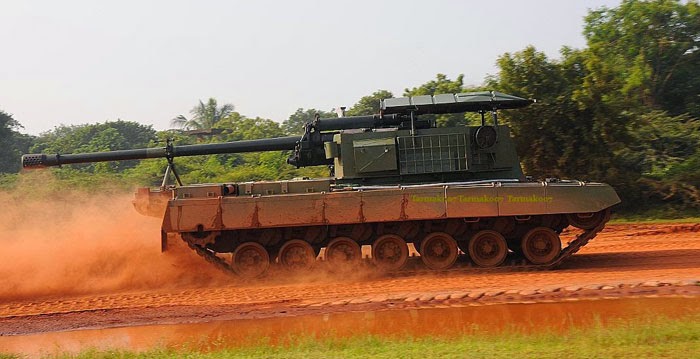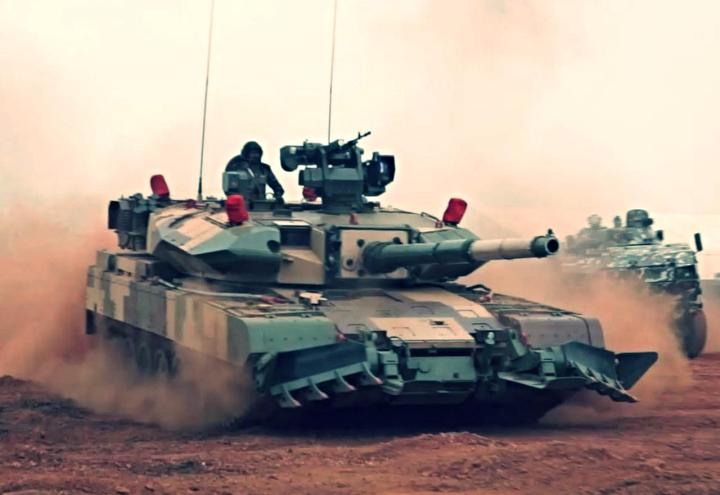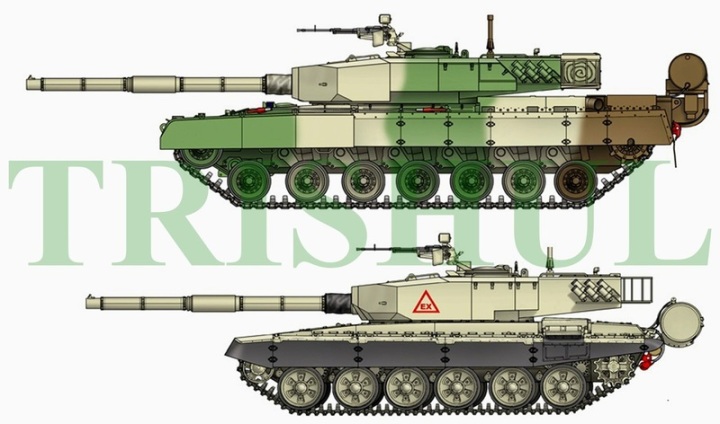Intro- Ever wondered why would a country which operates Russian tanks would develop a main battle tank on the lines of modern western MBTs? with its performance parameters closely resembling tanks like Leopard 2, M1 Abrams and Challenger 2. A tank which would be very different compared to the primary MBT operated by them. The answer is simple, to counter a western tank you need a similar tank. This tank would counter a western tank being actively marketed to the arch rival of this tank’s operator. In this article, we will have a look on the Arjun MBT, the first tank designed and built by India. This tank was never really accepted by its primary operator, which will be explained as well in this article. It is one of the most comprehensive articles ever written on Arjun tank, taking into account various factors that played a role in its development, deployment and service.
Vijayanta tanks on the roll
The Indo-Pak war of 1971 had left a lasting mark on Indian army’s operational procedures. Like all armed forces, it reviewed its actions, the performance of its equipment, personnel, standard operating procedures etc after the war ended. Even though they had won it comprehensively, there were some glaring problems. India operated the Soviet T-55s ,the British Vickers Mk1 and its locally produced variant named Vijayanta during the conflict. These tanks faced a lot of problems while operating in the tough Indian subcontinent conditions. Thus a requirement for a domestically designed and built tank was put up, which could be designed ground up to operate specifically in the region. Hence the project was started in 1974 with initial requirements set at 105mm main gun on a 40 tonne tank. The Indians greatly respected the Royal Ordnance L7 105mm rifled gun. It was an accurate tank killer and was capable of firing the HESH (High Explosive Squash Head) round, which didnt need penetration of armor to score the kill. Its shockwave was enough to injure the crew and damage the tank. Infact they fitted T-55s, imported from the Soviet Union with the same gun to improve its capability.
 Indian T-55s with L7 gun (Credits-On the pic)
Indian T-55s with L7 gun (Credits-On the pic)
In 1974, another event, which would play a major role in the development happened. India conducted nuclear tests in Pokhran and the world reacted with sanctions, thus weakening the Indian economy and its armed forces. The requirement for this tank was changed time and again to suite future conflicts in the region. Side by side, India wanted to procure another tank which would stand up incase Arjun didnt deliver on the promises. T-72M was selected over western tanks, even though it didnt meet some requirements, especially the HESH capability. It was similar in weight to the Vijanyanta tank and was cheap to operate and maintain. The political condition played a part in this procurement as well, as India had gone close to USSR even though it was a Non-Aligned Country. Thus the T-72M was procured off shelf at the start, followed by domestic production. It would form the backbone of the Indian army’s armored regiments for decades. India would end up procuring a 2400 strong fleet of these tanks.
The requirements for the new tank were changed again in the 1980s as a new tank was now being heavily marketed to Pakistan, which had a history of operating advanced American hardware. M1 Abrams was now being offered to Pakistan, another cutting edge American weapon system, which India feared would tip the advantage during a tank conflict in their favor. India was now under sanctions,thus couldn’t import western tanks, T-72Ms were few and early analysis showed that M1 was a beast of a tank and thus the Indians faced a major dilemma. M1 which was developed to make up for the cancelled MBT-70, a joint project between USA and West Germany, had a similarly capable German counterpart. This tank, following the German tradition of naming tanks after wild cats was named Leopard 2 and was an apt successor to its predecessor the Leopard 1. It sported a diesel engine instead of Abrams’s turbine which made it more reliable and longer ranged while sharing the same gun. The Leo 2 thus became an attractive option for the Indians, but they couldn’t import it directly due to the sanctions. Hence the Indians hired its designers as advisers in the Arjun programme. This answers the similarity between Arjun and Leo 2 MBTs. Thus M1 which was supposed to fight along side its German counterpart in Europe would now face a tank similar to Leo 2 as its enemy if it entered service with Pakistan.
 The undeniable similarities
The undeniable similarities
The tank was now supposed to be around 60 tonnes, sport a 120mm rifled gun with HESH capability thus capable of blunting the edge given by M1 to its adversary. Indians stuck to a rifled gun, developed using the technology of the L7 105mm gun due to its combat performance. It would have advanced sights and FCS so that the enemy could be spotted early and stopped in its tracks. The powerpack however was another problem. Due to the sanctions, German exported the older 1400bhp instead of the 1500bhp engine which powered the Leo 2. The ammo storage was derived from the Leo 2, ie rounds placed in individual canisters in the turret bustle and canisters in the hull beside the driver. Prototypes were developed around mid 1980s and had a tonne of problems. The rectification of these problems took a long time as this was the first tank being developed by the Indians.
Early Arjun prototypes (Credits-On the pic)
The delays were further extended by another event. In 1988, M1 performed poorly during trials in Pakistan and was thereby not procured. The tank missed most of its targets and broke down during the trials. Several modifications were thus done to the tank before it took part in upcoming conflicts in the middle east. Thus there wasn’t any need for Arjun as the prime adversary would not enter service. The speed of the programme was reduced as the army which was happy with the T-72M and its 125mm main gun and didnt want a new expensive tank. It would strain the established supply chains thanks to different components, ammo and weight, thus adding operational costs. The operational costs mattered alot as the Indian economy was not that strong and the defense spending was much lower than required. Although labelled indigenous, it had high foreign content, increasing the costs of operations even further. It was put on the back burner and the development was painstakingly slow.
Arjun Mk1 would only enter service in 2004 with the Indian army. Only 124 of the Mk1 variant were ordered. Less number didnt mean it wasn’t a capable tank. Its domestically developed Kanchan armor withstood hits from 3BM-42 Mango APFSDS round, the best the Russians exported. It sported FCS and gunner’s sight designed by Sagem, whereas the commander has his own panoramic sight. A crew of 4 operates the tank, it is commanded by a commander, driven by a driver and the main gun is operated by the gunner and the rounds are loaded by the loader. Indians didn’t want an autoloader, as it made maintenance difficult and persisted with a 4 man crew. They stuck with ammo arrangement seen in the Leo 2 and thus avoided the carousel storage seen on T-72Ms, which mad e it infamous for blowing up when hit. The turret is fairly similar to that of Leo 2, including placement of gunner’s sight, turret mantle, commander’s sight. The tank was powered by a 1400bhp engine of German origin and 7 roadwheels with hydro-pneumatic suspension would propel its 58 tonne bulk. The tank, along with internal fuel can carry 2 external tanks, akin British Challenger 2s and all Russian tanks.

A follow on order for MK1 was planned but never placed, but an improved Mk2 variant was ordered. The Mk2 sported around 60 improvements over the Mk1 and reduced imported content considerably. It sported domestically made sights, FCS, a new ERA, a better engine and several small and unseen improvements internally. Around 120 or so were ordered initially, but another 118 have been ordered as per speculations. Several other variants of Arjun are under development too. A bridge layer variant has been completed along with an self propelled howitzer using 130mm Catapult gun. A combat engineering vehicle is under development. With Denel out of blacklist, of the Indian MoD, there are chances that Bhim SPH ie Arjun chassis equipped with Denel T6 turret might be revived as well.
Bhim SPH (Credits-On the pic)
Indian army is known to have faced a lot on controversies due to this tank. They claimed it was difficult to transport on the existing logistical system used for the T-72M and T-90S. They also claimed that operating this tank would also need extensive changes in maintenance system as it is very different from what they were operating. All of these claims have been rubbished by the Indian MoD over the years and hence the army accepted Arjun-Catapult SPH and a second batch of over 100 Arjun MK2.
Arjun Bridge Layer Tank




















